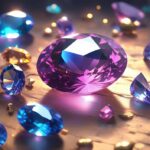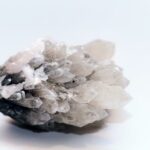Welcome to the fascinating world of turquoise jewelry, where the alluring beauty of this gemstone intertwines with its mesmerizing geological properties. In this article, we will embark on an exploration of the captivating secrets that lie within turquoise, unraveling its composition, formation process, and unique geological characteristics. Join me as we delve into the depths of this remarkable gemstone and unlock the geological wonders that make turquoise jewelry truly extraordinary.

Geological Properties of Turquoise Jewelry
Turquoise jewelry is not only visually stunning but also holds fascinating geological properties. In this article, we will explore the unique characteristics that make turquoise a captivating gemstone. Let’s delve into the world of turquoise and uncover the wonders hidden within its geological makeup.
Composition and Formation
Turquoise is a copper-containing basic aluminum phosphate with the chemical composition CuAl6(I(OH)2/PO4)4·4H2O. With a hardness of 5 to 6 on the Mohs scale, turquoise boasts both durability and beauty. Its waxy luster and blue-green color, adorned with brown/black veins of matrix, make it instantly recognizable.
Quote: “Turquoise, with its distinctive blue-green hue and intricate matrix, is a geological wonder that captivates the eye.”
Turquoise forms through the leaching impact of acidic aqueous solutions during the decomposition and oxidation of pre-existing minerals. This unique geological process gives turquoise its signature appearance. Its opaque nature and soothing energy make it an alluring gemstone, cherished for thousands of years in the world of jewelry.
Identification and Misidentification
Given the popularity of turquoise, it is crucial to know how to identify it correctly. Many minerals, such as variscite, chalcosiderite, and magnesite, resemble turquoise and are often misidentified. However, there are key distinguishing factors to consider.
Quote: “Distinguishing genuine turquoise from similar-looking minerals requires an experienced eye and a deep understanding of its geological properties.”
Synthetic turquoise, on the other hand, replicates the chemical, optical, and physical properties of natural turquoise with minimal variation. Therefore, it can be challenging to differentiate between the two without specialized knowledge.
Enhancements and Stabilization
To unlock the full potential of turquoise and enhance its durability, it is often subjected to treatments. Stabilization is a commonly used technique to improve the overall strength and polish of turquoise. Through stabilization, the stone retains its geological properties while becoming more resistant to wear and tear.
Quote: “Stabilization breathes new life into turquoise, unveiling its natural beauty while preserving its geological essence.”
Additionally, some turquoise is dyed to achieve a more even and vibrant color. While dyeing can enhance the visual impact of turquoise, it is essential to be aware of this treatment when purchasing turquoise jewelry.
The Magic of Turquoise
Turquoise’s geological properties make it more than just a stunning gemstone. Its soothing energy and oceanic beauty have captured the hearts of countless individuals throughout history. From ancient civilizations to modern jewelry lovers, turquoise continues to inspire and enchant.
Quote: “Turquoise, with its tranquil aura and oceanic allure, has the power to transport us to a place of serenity and natural beauty.”
Whether worn as a statement piece or passed down through generations, turquoise jewelry is a testament to the enduring allure and geological wonder of this remarkable gemstone.
In conclusion, turquoise jewelry unveils a world of geological wonders. Its composition, formation, identification, and enhancements all contribute to its unique beauty and appeal. By appreciating and understanding the geological properties of turquoise, we can truly admire the intricate marvel that this gemstone represents.
Table: Turquoise Facts
| Geological Property | Understanding |
|---|---|
| Chemical Composition | CuAl6(I(OH)2/PO4)4·4H2O |
| Mohs Hardness | 5 to 6 |
| Formation | Leaching impact of acidic aqueous solutions on pre-existing minerals |
| Appearance | Blue-green with brown/black matrix veins |
| Enhancement Techniques | Stabilization, dyeing |
| Similar Minerals and Misidentification | Variscite, chalcosiderite, magnesite |
| Synthetic vs. Natural Turquoise | Replication of properties with little variation |
Turquoise jewelry is known for its captivating beauty and timeless appeal. If you’re looking to add a touch of elegance to your outfit, why not explore our exquisite collection of turquoise jewelry? From stunning necklaces to delicate earrings, our selection offers a wide range of designs that are sure to turn heads. Discover the perfect piece to express your individuality and style today. Turquoise Jewelry awaits you.
FAQ
Question 1
What is the typical appearance of turquoise jewelry?
Answer 1
Turquoise jewelry typically has a blue-green color with brown/black veins of matrix running through it, giving it a distinctive and unique appearance.
Question 2
Is turquoise dyed to enhance its color?
Answer 2
Yes, some turquoise is dyed to give it an evenly vivid color. This dyeing process is used to enhance the natural hue of the gemstone.
Question 3
Why is turquoise stabilized?
Answer 3
Turquoise is often stabilized to improve its overall strength and polish. Stabilization prevents the gemstone from becoming brittle and helps maintain its durability over time.
Question 4
What is the chemical composition of turquoise?
Answer 4
The chemical composition of turquoise is CuAl6(I(OH)2/PO4)4·4H2O. It is a copper-containing basic aluminum phosphate that gives turquoise its unique properties.
Question 5
How is turquoise formed?
Answer 5
Turquoise is formed through the leaching impact of acidic aqueous solutions during the decomposition and oxidation of pre-existing minerals. This intricate process results in the formation of opaque, blue-to-green hydrous phosphate of copper and aluminum known as turquoise.
- Crypto Quotes’ Red Flags: Avoid Costly Mistakes - June 30, 2025
- Unlock Inspirational Crypto Quotes: Future Predictions - June 30, 2025
- Famous Bitcoin Quotes: A Deep Dive into Crypto’s History - June 30, 2025
















